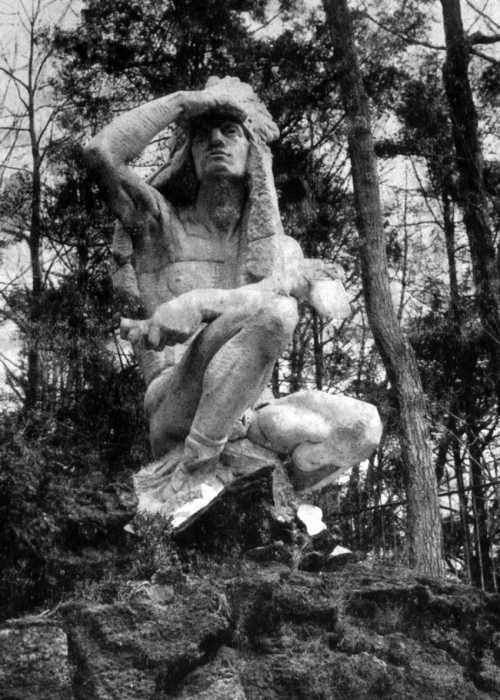1. Lake Teedyuskung was named for Teedyuscung, (1700-1763) a spokesman of the Susquehanna Delaware Indians. He worked and fought unsuccessfully to get his people a deed for land to be reserved for them in perpetuity. The request was not granted. Teedyuscung, with his band of Susquehanna Delawares, remained at Wyoming (now Wilkes-Barre) for some uneasy years, keeping an eye on the trail from Cushetunk on the upper Delaware, where armed Connecticut ‘settlers’ were assembling in a body for an advance into the disputed valley.
2. The trouble came to a head in 1762, when the New Englanders began to cut a wagon road from Cushetunk and prospecting parties arrived at Wyoming. Teedyuscung warned them off. He was offered pay if he would join them in surveying the land. He refused. They stole his horse and he threatened to arrest them and take them to the governor in Philadelphia. They gave him a new horse and decamped, saying, however, that they would return in the spring with thousands of armed men. The Six Nations (Iroquois) stood behind him and in March, 1763, promised the New Englanders war if they attempted to seize the valley.
3. On April 19, 1763, Teedyuscung was burned to death in his cabin. Almost at the same time twenty other Indian houses in the town went up in flames. The surviving Indians fled and did not return. Two or three weeks after the murder, Connecticut families took up residence in the valley. On October 15, 1763, there occurred the first Massacre of Wyoming. That was when Captain Bull, a son of Teedyuscung, swept through the valley with a Delaware war party and left no white people alive in it. Five years later, in 1768, the Iroquois sold the land to the Pennsylvania Government.

Tedyuscung (c. 1700-1763), a Delaware Indian, represented the grievances of his people at conferences with the white authorities during the 1750s and 1760s. It was widely believed that Quaker leaders, anxious to embarrass the Proprietors of Pennsylvania, the Penn family, largely controlled Tedyuscung in his charges of land frauds levelled at the Penns. But Tedyuscung was difficult to manage as he was so frequently drunk. A wooden statue “dear to the heart of every boy” crowned a height in the Wissahickon. When it began to decay (it is now preserved in the Germantown Historical Society) Mr. and Mrs. Charles W. Henry commissioned Phind to replace it, and his majestic Indian has long been a noted Wissahickon landmark. In 1907 the architect Albert Kelsey claimed that it was “merely a duplicate of one of the four figures which adorn a public fountain in Hartford, Connecticut, and might just as well stand for a cigar store Indian as for the legendary chief.”
From “Chestnut Hill Local” newspaper, December 13, 1990, p.64:
“Was either (the first statue or the present one) meant to represent Tedyuscung? There has been confusion arbout this since the time each was erected. Mrs. Henry clearly stated that the statue was not Tedyuscung but an Indian chief gazing westward where his people had gone. The statue itself was one of several identical ones of an Indian chief created by J. Massey Rhind, a New York sculptor, in Hartford. However, newspapers, various accounts, even the minutes and reports of the Fairmount Park Commission refer to the statue as Tedyuscung. At the dedication of the Henrys’ statue the main speaker, obviously not aware of Henrys’ informations, called it Tedyuscung and devoted his talk to what he knew of the Indian’s life. It is most likely that the identification of the with Tedyuscung began with the Rev. Thomas Middleton, a respected historian and president of the Catholic Historical Society, writes (in a history of Our Mother of Consolation Church) that he “was witness of the erection on the summit of Council Rock of the first image (in wood) of the venerable Tedyuscung.” He speaks of “the discussions to determine just how to guide the artist that was to paint the wooden icon of the departed Lenni Lenape brave and adorn him with the colors proper to his race and tribe. He found bills for the statue among his father’s papers. They totalled $22.17. According to newspaper articles, William C. Wimmer, a Philadelphia artist, drew and colored the statue, which Middleton and others placed in position on 28 July 1856 “in commemoration of Tedyuscung’s last visit to this spot, which happened just one hundred years ago.”
Today there are a few Delawares in Wisconsin. The greater number of Delawares moved west to Ohio, or to a reservation in eastern Kansas, then south into Oklahoma, some settling among the Cherokees there.
“Indians in Pennsylvania”, Harrisburg, Pennsylvania Historical and Museum Commission, 1970, Paul Wallace, author .

